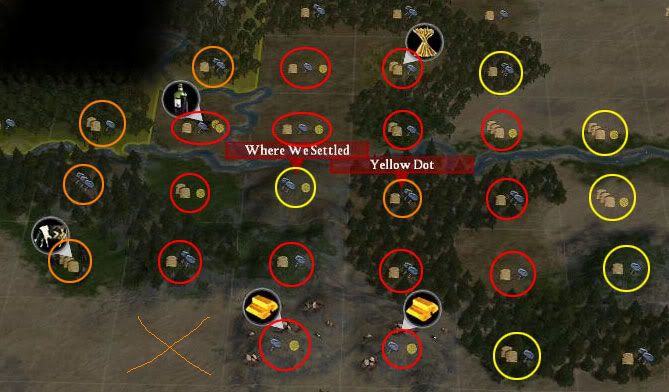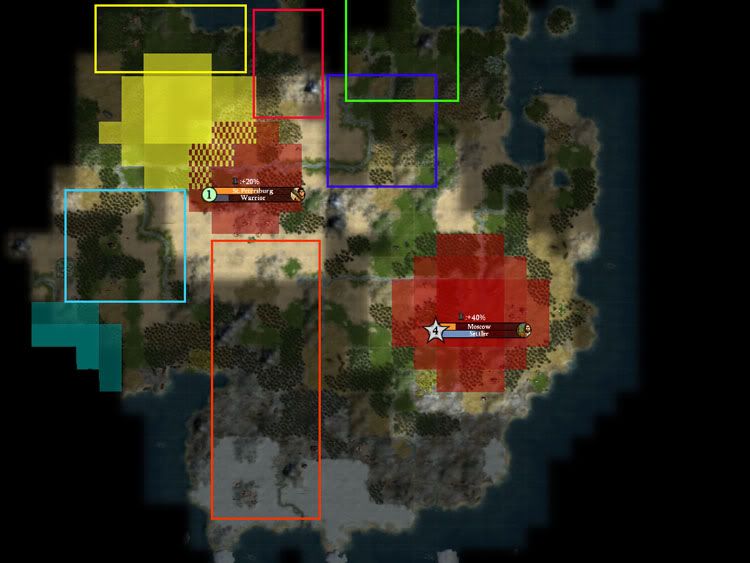Sorry. But I obviously settled a stronger spot as long as it has access to the cows aswell?
Hmm... ok again my fault for not properly explaining the dots, and the in depth purpose behind them. Obviously there was possible debate about the tundra dots, but I was fairly certain we were all agreed upon about the northern dots, so I didn't do an in depth analysis of them for you guys. I didn't expect there to be a unilateral change in the first town placement.
-----
Let's start with a tile counting exercise. I've turned on the tile yields and highlighted them for ease of counting.
Let's first count what both dots share...
-1 Flood Plain
-5 plains, 2 of them riverside
-2 Grasslands, both riverside
-2 Grassland Hills
-2 Gold
-1 Wine
-1 Wheat
Ok, let's see what we won by settling on that hill... (yields assume mines and farms, I realize that we cannot irrigate all spots until Civil Service, but since all the tiles in question are forested, we can still get 3 total food + hammers from it. I make this assumption because we must automatically assume the cows are improved.)
-2 riverside plains : 2 x 2/1/1
-1 riverside grassland : 3/0/1
-1 riverside plains hill : 0/4/1
-1 Cow : 4/2/0
-1 desert tile (useless)
Total Yield: 11/8/4
What would we have had if we settled on Yellow Dot?
-2 flood plains : 2 x 4/0/1
-1 grassland : 3/0/0
-1 plains : 2/1/0
-1 riverside plains hill : 0/4/1
-1 grass hill : 1/3/0
Total Yield: 14/8/3
So in reality we have sacrificed 3 food to gain 1 commerce. Just considering the tile yields, this is already a losing proposition. 3 food is, at worst, 1 and 1/2 merchants or scientists, which is 4.5 modified commerce, if you want to translate it directly like that.
-----
The other factor is the proximity to Ramesses Capital. We didn't know he was going to get Jud, but the fact that we founded the town on the same turn he
converted to Jud should have sent massive alarm bells off. After that, it was complete

to settle
closer to his capital than before.
His Capital is now putting out 2+5 culture, +1 more probably due to an obelisk that the guy is sure to run. We put out 2 culture per turn and are quickly being overrun. This will antagonize Ramesses as he will be quicker to say that our borders are too close, and we'll incur diplo penalties for that first. The point of this exercise was to
block Ramesses, not to antagonize him into attacking us (see Boff-05 for blocking AIs so they go fight each other rather than us).
From a practical yields perspective, we have lost even more, as the tiles overlap with his capital, so we will not be controlling them until we attack him, and our early strategy was supposed to be REX, not axe-rush. Obviously deviating from your strategy is necessary if the AI does something you need to react to, but if you are deviating from your strategy for pointless reasons (like changing city locations without considering all the consequences), you needlessly weaken your strategy and make it more difficult for yourself.
As it stands right now, we don't control 5 tiles in our BFC. If we had settled yellow, that number would be 2 tiles. I have no idea when the culture at Ramesses capital expanded (as the report wasn't done as a turn-by-turn), so I can't calculate the exact timing, but we
will be chewing on Egyptian culture in our city center within the next 100 turns (which would have been otherwise spent REXing). This hurts the stability of the city, and we have to waste time building a ton of culture here. If we had settled at the original yellow dot, we would have had until Ramesses reached 7500 culture (not happening soon) until culture pushed into the city center. By then, we would have had ample time to REX and strengthen our empire to take the guy out. Now we may be forced into action before we've had a chance to exploit the lands through settling.



 to settle closer to his capital than before.
to settle closer to his capital than before.
 and Blue dot for support. Those two towns block the rich center From hammy as I'll try and show in an edit (need to get food)
and Blue dot for support. Those two towns block the rich center From hammy as I'll try and show in an edit (need to get food)

